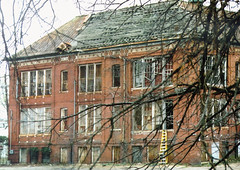A thought or two on public assets and public schools
 Photo by Peter Sefton. I joke that the DC Government's primary asset management strategy is "demolition by neglect." I will say that this building here has been stabilized due to the intervention of Councilmember Jim Graham and the responsiveness of the "new" director of the Office of Property Management, Carol Mitten.
Photo by Peter Sefton. I joke that the DC Government's primary asset management strategy is "demolition by neglect." I will say that this building here has been stabilized due to the intervention of Councilmember Jim Graham and the responsiveness of the "new" director of the Office of Property Management, Carol Mitten.I am increasingly interested in how municipalities think about, plan, and coordinate the utilization of physical public assets. I suppose there are many levels of consideration--infrastructure (streets and utilities), emergency services, public transit, etc.
At the neighborhood level, the three agencies that have the most impact on residents are the schools, parks and recreation, and library agencies. At least in DC, these agencies look upon their "portfolios" independently, and as owned by the agency, not the citizens. Certainly the provision of services is independent of the other agencies, as is their various missions. If they thought of their missions more broadly and linked i.e., "providing opportunities for citizens to grow and learn and enrich their lives and communities", in theory it would result in different activities, the coordination of services etc.
Imagine a school in an urban setting, but where they locate their library and media resource facilities (i.e. computers, etc.) at the front of the building, perhaps with separate entrances, so that the facilities can be open to the public particularly at times when the school is closed.
This organization New Schools for Better Neighborhoods has some of the ideas, but I don't like the idea of building new schools as much as I like the idea of asset utilization and reconceptualization of mission. Kids don't need 40 acre campuses. They need decent schools with decent teachers, high expectations, and engagement with the community.
There is an interesting article about "positive deviance" in the May issue of the Harvard Business Review. There is a very interesting case study about the schools in a poor state in Brazil where the teachers hadn't been paid in 6 months, and the test results for the entire province were about 50% worse than the national average. Yet some schools were amongst the highest performers in the country. It turned out this is because they engaged the parents into the learning process by creating family learning contracts, and because the parents were often illiterate the children were able to help the families apply for government benefits and the like--making the whole family committed and engaged in the education process.
This idea of the family learning contract has a lot of relevance to urban school systems.



0 Comments:
Post a Comment
<< Home